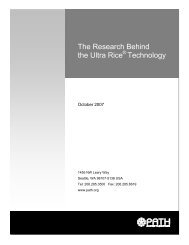Business Investing in Malaria Control: Economic Returns and ... - Path
Business Investing in Malaria Control: Economic Returns and ... - Path
Business Investing in Malaria Control: Economic Returns and ... - Path
Create successful ePaper yourself
Turn your PDF publications into a flip-book with our unique Google optimized e-Paper software.
Figure A.5 illustrates the malaria episodes averted by each company.<br />
Figure A.5<br />
Estimated malaria episodes averted for Mopani Copper M<strong>in</strong>es, Konkola Copper M<strong>in</strong>es <strong>and</strong> Zambia Sugar<br />
<strong>Malaria</strong> episodes<br />
(thous<strong>and</strong>s)<br />
<br />
<br />
<strong>Malaria</strong> episodes<br />
(thous<strong>and</strong>s)<br />
<br />
<br />
12<br />
Basel<strong>in</strong>e<br />
12<br />
Basel<strong>in</strong>e<br />
9<br />
6<br />
Effect of private<br />
<strong>in</strong>terventions<br />
9<br />
6<br />
3<br />
Actual<br />
3<br />
Actual<br />
0<br />
0<br />
2001 2002 2003 2004 2005 2006 2007 2008 2009<br />
2001 2002 2003 2004 2005 2006 2007 2008 2009<br />
<strong>Malaria</strong> episodes<br />
(thous<strong>and</strong>s)<br />
<br />
BUSINESS INVESTING IN MALARIA CONTROL: ECONOMIC RETURNS AND A HEALTHY WORKFORCE FOR AFRICA<br />
Sources: Health Management Information Systems, Central Statistics Office, Zambia; company data.<br />
Company cl<strong>in</strong>ics recorded greater reductions<br />
<strong>in</strong> malaria cases than public-sector cl<strong>in</strong>ics. That<br />
is, actual malaria cases fell at higher rates than<br />
basel<strong>in</strong>e malaria cases. This difference is less<br />
dramatic <strong>in</strong> Mazabuka District (Zambia Sugar)<br />
where much of the population is affiliated with the<br />
company <strong>and</strong> the company-based control effort<br />
affected a higher proportion of the population<br />
overall.<br />
Step II: Medical cost sav<strong>in</strong>gs<br />
In order to calculate health-care cost sav<strong>in</strong>gs<br />
associated with malaria prevention, averted<br />
12<br />
9<br />
6<br />
3<br />
0<br />
Actual<br />
Basel<strong>in</strong>e<br />
2001 2002 2003 2004 2005 2006 2007 2008 2009<br />
malaria episodes were divided <strong>in</strong>to <strong>in</strong>-patient <strong>and</strong><br />
out-patient cases. It was assumed that the ratio<br />
of <strong>in</strong>-patients to out-patients was not affected by<br />
private-sector <strong>in</strong>terventions.<br />
Separate data on <strong>in</strong>-patients <strong>and</strong> out-patients<br />
were not available at Zambia Sugar. It therefore<br />
was assumed that no <strong>in</strong>-patients were admitted<br />
at Zambia Sugar. That is, all malaria episodes<br />
were considered to be (less challeng<strong>in</strong>g <strong>and</strong> less<br />
expensive) out-patient cases. Us<strong>in</strong>g the basel<strong>in</strong>es<br />
from Step I, the <strong>in</strong>-patient <strong>and</strong> out-patient trends<br />
displayed <strong>in</strong> Figure A.6 were derived.<br />
50
















